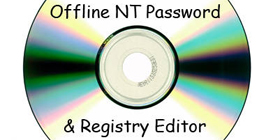 There are lots of methods available to recover or reset the Windows password. The famous Ophcrack is used for recovering the password. The disadvantage of Ophcrack is that we need to download a file of size 500MB to recover the password. Thus as a replacement of Ophcrack we can just use a 3 MB file open source program. I have not found any other method simpler than this one, it resets your password just in seconds.
There are lots of methods available to recover or reset the Windows password. The famous Ophcrack is used for recovering the password. The disadvantage of Ophcrack is that we need to download a file of size 500MB to recover the password. Thus as a replacement of Ophcrack we can just use a 3 MB file open source program. I have not found any other method simpler than this one, it resets your password just in seconds.The method uses an open source program called Offline NT Password & Registry Editor.
A USB Disk Drive (Pen Drive) or burn a bootable CD can be used.
A help Guide is presented below To use this software:
Follow these simple steps
Step 1:
Download the cd110511.zip file for the Bootable CD image.(~3MB Size)
or, Download the usb110511.zip files for USB install.(~3MB Size)
From the below links these files can be downloaded:
For Bootable CD image : http://pogostick.net/~pnh/ntpasswd/cd110511.zip
For USB install: http://pogostick.net/~pnh/ntpasswd/usb110511.zip
Step 2:
Burn the ISO file to a CD.
How to make the CD
1. There is an ISO image file (cd??????.iso). This can be burned to CD using whatever burner program you like, most support writing ISO-images.The CD will boot with most BIOSes, see your manual on how to set it to boot from CD. Some will auto-boot when a CD is in the drive, some others will show a boot-menu when you press ESC or F10/F12 when it probes the disks, some may need to have the boot order adjusted in setup.
If you are using a USB drive then the method to use it given below:
To make a bootable USB drive / key:
1. Copy all files from this CD onto the USB drive.It cannot be in a subdirectory on the drive.
(Note: You do not need delete files already on the drive.)
2. Now make your USB bootable by following methods: (you may have to be administrator)
On the USB drive, there should now be a file "syslinux.exe". Then Open command Prompt (Press Start +R, Type cmd and enter) and then follow options 1 & 2 below:
1. h:
2. syslinux.exe -ma h:
Here, 'h' is my drive letter you must put your own drive letter.
In case of ERROR (on some drives) you must omit the '-ma'.
If it says nothing, it have made your USB bootable or the bootloader is installed.
Step 3: ( Get Started )
1. Now start the System which you want to reset the password by putting the CD or the USB in the Computer.
2. While start up you have to make sure that it boots up from the correct device i.e. from the CD or the USB.
(In order to do this go to your BIOS settings and change the boot order as CD or the USB drive as the first option. Or if you know the Boot menu key then press it and Boot from the correct device.)
Step 4: (Now lets reset by following few easy steps!!!!!!!!)
1. After booting from the CD or the USB, press enter to continue the boot process.
2. In the first step it will automatically select the disk where your windows is installed. Simply press enter to continue.
3. In the Second Step it Will select the path and registry files. Select 1 for password reset (It will select 1 by default, just enter).
Step 5:
Now after selecting the paths, It will ask “What to do?” Simply press enter as it will automatically select 1 for Edit User Password.
Step 6:
1. It will show a list your system usernames and their password status.
2. Now enter the username whose password you want to reset. It is case sensitive so, be careful and type what you see in the users list. (If the user is Administrator just press enter as it has already selected Administrator by default otherwise enter the correct username)
Step 7: It will show you User Edit Menu. Select 1 to clear the user password.
Step 8:
1. It will clear the password. Now Enter “!” to quit from the User select menu.
2. It will again ask “What to do?”. enter “q” to quit.
.
3. Now it will ask you to write the files or not. Enter “y” to write the files. It will write the files back. Now Simply press enter when it asks for “New run?” as it has selected no by default. The password reset has been successfully completed.
4. Now restart the computer and you will find that it is not asking for password for the user you had selected. That’s it, you are done.
Important:
1. Other supporting articles will be posted soon.2. The method has been tested for windows XP, Windows Vista and Windows 7 and all resulted in success.
3. This is for information purposes only. We are not responsible for any damages or illegal acts resulting from this information.
4. The information provided here should be used for legal purposes only.
5. USB Disk method will not work if your motherboard or BIOS does not support USB booting.
for this method.
























1 comments:
eh k ho esto.....ayepachi sab sikaunu parcha....sure hai bro!!! ma sachikai auchu...
Post a Comment